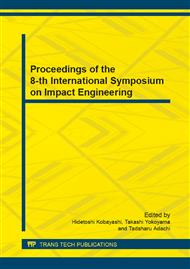p.56
p.61
p.67
p.73
p.80
p.86
p.92
p.97
p.104
High Strain-Rate Compressive Behavior and Constitutive Modeling of Selected Polymers Using Modified Ramberg-Osgood Equation
Abstract:
The present paper is concerned with constitutive modeling of the compressive stress-strain behavior of selected polymers at strain rates from 10-3 to 103/s using a modified Ramberg-Osgood equation. High strain-rate compressive stress-strain curves up to strains of nearly 0.08 for four different commercially available extruded polymers were determined on the standard split Hopkinson pressure bar (SHPB). The low and intermediate strain-rate compressive stress-strain relations were measured in an Instron testing machine. Six parameters in the modified Ramberg-Osgood equation were determined by fitting to the experimental stress-strain data using a least-squares fit. It was shown that the monotonic compressive stress-strain behavior over a wide range of strain rates can successfully be described by the modified Ramberg-Osgood constitutive model. The limitations of the model were discussed.
Info:
Periodical:
Pages:
80-85
Citation:
Online since:
June 2014
Authors:
Price:
Сopyright:
© 2014 Trans Tech Publications Ltd. All Rights Reserved
Share:
Citation:


